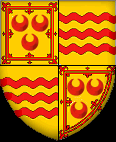| |
|
Olivestob Estate and House |
|


Located within
sight of the former Palace of Seton immediately to the south of
Prestonpans and near the town of Tranent in East Lothian, is the
Estate of Olivestob, now called Bankton House, separated from
the town by the railway. This 17th Century mansion takes the
form of a central block with two pavilions, lying to the east
and west, all decorated in distinctive orange lime harling. Of
the two pavillions running eastern and west, the western
pavilion which once incorporated a doo'cot and now contains a
small exhibition recording the history and restoration of the
house. Formerly the residence of Sir Thomas Seton, who was
created a Baronet of Nova Scotia under King Charles, and who's
portrait resides at Traquair House, was the fourth son of Robert
Seton, 1st Earl of Winton and Lady Margaret Montgomerie later
heiress of Eglinton.
The original
building was erected in the late 12th century and was associated
with the monks of Newbattle Abbey, who had been granted charters
to much of the surrounding area and became known as Holy Stop
(later Oliestob). The property passed through the hands of Mark
Ker, Earl of Lothian (1553 - 1609), Sir Alexander Morison of
Prestongrange (who purchased it in 1632) and the Setons of
Winton and, through marriage, to the Hamilton family. It was
also occupied by lawyer Sir Hew Dalrymple (1690 - 1755) for a
time. Around 1742, the house and estate was sold to the
celebrated Col. James Gardiner (1687 - 1745), who died nearby at
the Battle of Prestonpans. Thereafter the house was bought by an
Edinburgh advocate, Andrew M'Douall, who took the title Lord
Bankton when he was promoted to the bench. This name then became
attached to the house.
Adjacent, to the
west, was the site of the former Bankton Colliery and the house
was acquired by the government-owned Coal Board. Having become a
ruin, the house was restored and converted into flats by the
Lothian Building Preservation Trust between 1988 and 1995, with
grants from Historic Scotland, the European Regional Development
Fund, East Lothian District Council and Scottish Natural
Heritage. An old orchard was replanted on the north side of the
house at this time. This includes numerous varieties of apples,
pear, plums, quinces, medlars, gages and damsons.
| |
 |
 |
Olivestob Gallery
Bankton House

A History of Olivestob

Details of Olivestob

Photo of Olivestob

Restoration Details
Restoration Notice
The Battle of Prestonpans
|